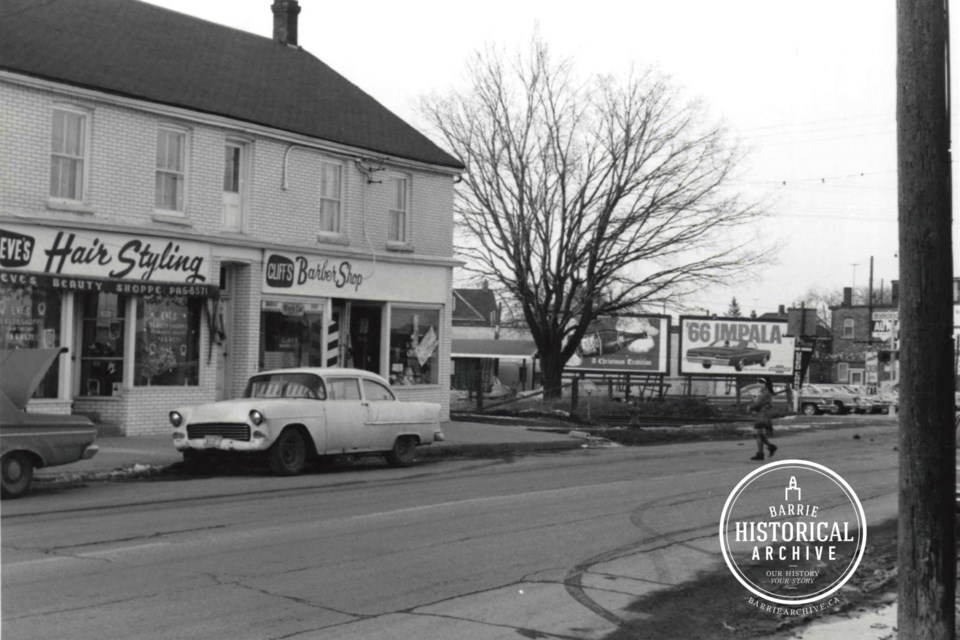Old-time barbers were an unusual class of businessmen. They offered utilitarian haircuts to the working class while a wide range of frivolous and pampering services were available to those with extra money to spend. These premier options often bordered on medical treatments and included some questionable lotions, potions and devices.
Perhaps in an attempt to lend some legitimacy to their array of goods and services, many barbers bestowed the rank of professor upon themselves. This was the 1860s and 1870s, an era when no one asked too many questions.
Andrew Cunio was likely the first hairdresser in Barrie. During these early days, hairdresser was preferred over the term barber. The hairdresser’s work was all about men’s coiffures as women rarely sought professional styling in this era. In fact, it was seen as sort of unseemly for a woman to attend a hairdresser shop.
Professor Cunio operated a hairdresser shop just across from the present-day Queen’s Hotel and offered his customers a five-cent shave, haircutting, hair oils and invigorating lotions and treatment with his home-produced Professor’s Hair King wash.
This special shampoo was actually a hair dye. It would have been a scandalous thing to see a woman with coloured hair in the 1870s, but it was fairly common practice for men at the time.
“When you leave here for the street, Your friends will smile when them you meet, And say what makes your hair so dark, Oh, it was the Professor’s Hair King wash, and he can do you black or brown.”
What the local hairdressing services couldn’t provide could be had through touring sales events from larger communities. A regular visitor to town was Professor Hildebert Dorenwend, a German émigré and proprietor of Paris Hair Works on King Street East in Toronto.
From about 1880, he would set up shop in the Barrie Hotel and peddle his wares to the townspeople of this community.
“Front pieces, bangs, switches and wigs. Also sole manufacturer of Curline, the new preparation for curling, crimping and frizzing the hair. Dr. Dorenwend’s German Hair Magic, a massive restorative of faded and gray hair, a promoter of growth and a sure cure for dandruff. Golden Hair Wash for producing a golden blonde shade. The above preparations are guaranteed to produce nothing injurious.”
With the licensing of barbers and hairdressers in the early 20th century, these rather dubious elixirs were placed in the care of pharmacists. In 1913, H.G. Robertson’s drug store was the sole local dealer in Newbro’s Herpicide, a then well-known brand of hair restorative.
In 1899, Dupont Newbro, a drug store owner and copper mine executive, enlisted the help of a bacteriologist to create a preparation that would kill the so-called dandruff germ that he theorized to be the cause of all cases of baldness.
This product sold like crazy for half a century. Amazingly, its labels carried no list of ingredients even after it was mandatory to do so. In 1941, the Food and Drug Administration in the U.S. took them to court and the ingredients were finally revealed — salicylic acid, glycerin, alcohol, brucine and perfume. Essentially, it was a pleasant-smelling blend of acne medication and a potentially deadly poison.
Just because they could no longer sell bottles of cure-alls, it didn’t mean barbers were completely out of the hair-restoration game. In January 1914, Earl DeGeer began promoting the latest addition in tonsorial technology to arrive in his Dunlop Street East barber shop. He called it the barber’s X-ray machine.
The process included having his customer hold a glass tube through which Mr. DeGeer would send a stream of violet electricity up the customer’s arm. When the barber touched the client’s hair, sparks jumped out, supposedly effecting some kind of cure.
“Darken his gray hair, a rosy colour to his cheeks that will last five to ten hours, cure that terrible headache of the ‘morning after’, chase away warts, moles and end with the newest shampoo and massage.”
I don’t know, but if I were a gentleman customer in a barber shop of the past, and had this information at hand, I might be inclined to head for the door when “next, please” was called.



